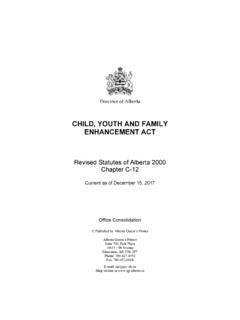Transcription of PLAINS MIDSTREAM CANADA
1 PLAINS MIDSTREAM CANADAREPORT TO STAKEHOLDERS AND COMMUNITIES30% Post-Consumer recycled content RELEASE DATE DECEMBER 2014 The facility at Fort Saskatchewan, facility in Sarnia, PMCOn the cover: An NGL storage tank at our facility in Shafter, MIDSTREAM CANADA ULC (PMC) specializes in transportation, processing, storage and marketing solutions for crude oil, natural gas and natural gas liquids (NGL). We link petroleum producers with refiners and other customers via pipeline, truck and rail transportation. PMC also operates strategically located facilities for crude oil and NGL storage, the separation of NGL from natural gas as well as the fractionation of NGL into specification products. With our expertise in logistics and marketing services, PMC is positioned to provide our customers with flexible, value-added services. PMC is headquartered in Calgary, Alberta. Our facilities are located in four provinces and 14 states. We conduct business in eight provinces and 45 MIDSTREAM CANADA ULC is an indirect subsidiary of PLAINS All American Pipeline, PLAINS All American is a publicly traded master limited partnership headquartered in Houston, Texas.
2 Its common units are traded on the New York Stock Exchange under the symbol PAA. WHAT S INSIDEFrom Our PresidentOur OperationsOur People and SafetyOur Processes and ProgramsOur Communities241216 28A fleet of more than 750 PMC trailers move crude oil, condensate and facility in Sarnia, BEGINNINGSP lains MIDSTREAM CANADA ULC (PMC) began operations in 2001 when PLAINS All American (PAA) saw an opportunity to enter the Canadian market. PAA merged Murphy Oil Company Ltd. s crude oil pipeline, storage and terminal assets with the marketing knowledge of CANPET Energy Group Inc., a privately held, Calgary-based Canadian crude oil and NGL MIDSTREAM Energy Group Inc. was established in 1985 after crude oil was deregulated in CANADA . Small crude oil producers were looking for marketing expertise that they could not build within their own companies, and CANPET provided this expertise. As the industry changed, it became necessary to own infrastructure, including pipelines, terminals, storage and other transportation assets.
3 PMC has grown substantially since 2001, completing more than 34 acquisitions, including the Rangeland Pipeline Company in 2006 and the Rainbow Pipe Line Company Ltd. in 2008, both in Alberta. The largest single acquisition occurred in 2012, when PMC purchased BP CANADA s natural gas liquids business. Assets included NGL extraction plants, pipeline gathering systems, fractionation plants, and storage and distribution facilities. In the early years, PMC grew by acquiring assets from large companies wanting to divest MIDSTREAM infrastructure outside of their core business and from independent operators who could not maximize the value of their assets on their own without the strength and flexibility of PMC behind them. In many cases we have invested substantial amounts to bring these new assets above industry standards. We currently have a large asset footprint with a substantial portfolio of project opportunities and have changed our focus from acquisitions to organic report to Stakeholders and CommunitiesWhen PMC began operations in 2001, we embarked on a path of dynamic and focused growth.
4 We started as a small operation with only 130 employees, and now have a team of more than 1,250 dedicated personnel working in four provinces and 14 states. We have expanded our oil and natural gas liquids business to create an organization that plays a pivotal role in CANADA s MIDSTREAM oil and gas is a young company, but our strategic growth has resulted in the planned expansion of our facilities and services and the purchase of key assets that support our long-term vision. We have completed more than 34 acquisitions since 2001, including our largest: the 2012 purchase of BP CANADA s natural gas liquids business. Throughout this period of substantial growth, we worked continuously to protect the environment, the public, our employees and contractors. Despite our best efforts, we encountered major challenges from two pipeline failures and product releases. We sincerely apologize for these pipeline failures and recognize the negative impact they had on individuals and local communities where we operate.
5 We are accountable for what happened, and in June 2014, we pleaded guilty to the charges resulting from these events. While it s fortunate that there were no injuries or any lasting environmental damage from either pipeline failure, we take these matters seriously and have redoubled our efforts to avoid such occurrences in the , like people, are measured not only by their success but by how they respond to have expanded our senior management team to provide focused oversight in key departments, engaged third party experts to assist our efforts, and recruited specialists to strengthen our organization. Since 2012, we have added four operationally dedicated executives and 57 new positions focused on Asset Integrity; Health, Safety and Environment; Regulatory and Permitting; Control Centre; and Emergency Response also accelerated our change process with the development of a new Operations Management System to allow us to enhance and standardize programs and processes across our organization, particularly in such critical areas as safety and asset integrity.
6 FROm OUR PRESIdENt 3 FROm OUR PRESIdENtA recent company-wide safety survey helped all employees and contractors to recognize safety risks in all aspects of our business. In addition, the survey established baseline practices and identified areas where we could improve. Several new initiatives have been implemented to enhance safety and consistency across our operations. We are integrating programs proactively across PMC that provide a more comprehensive approach to asset integrity. We have made substantial investments in in-line inspection and integrity dig programs, while collaborating with the Pipeline Integrity Working Group of the Canadian Energy Pipeline Association to further improve the capabilities of in-line inspections. We ve enhanced our watercourse crossing management program, using industry-leading risk assessment software to predict pipeline exposure risk. As the industry has evolved, we continue to invest in new technologies for pipeline monitoring and leak detection in an effort to achieve enhanced safety and a result of these actions, we believe PMC is now well positioned to continue to improve our performance, and we are moving forward with a clearly defined vision of our future PMC, we are excited about the changes underway and the progress we have made.
7 We strive to be responsive to our stakeholders in a manner that is transparent and credible. In order to achieve that objective, we are committed to producing an annual report to Stakeholders and Communities to share information on our initiatives and how we believe they will improve our performance in key business areas. Thank you for taking the time to review our first report . We respect and welcome your feedback and encourage you to complete the comment card at the back of this report . Alternatively, send us an email to let us know how you believe we can further improve. W. david duckett President PLAINS MIDSTREAM CANADA ULCP resident David Duckett and members of the Executive report to Stakeholders and CommunitiesOUR OPERAtIONS* PLAINS MIDSTREAM CANADA s Assets as of September 30, 2014. For more details, please visit our website: OUR OPERAtIONS OUR OPERAtIONS 5 GGas FacilitiesSStorage FacilitiesRRail terminalsCrude OilFFractionation Facilitiesttruck terminalsPipelinesNatural Gas Liquids (NGL)Crude Oil and NGLP lains MIDSTREAM CANADA s Assets at a Glance Crude oil: 5,100 kilometres of pipeline 394,000 barrels per day (pipeline volume) million barrels of tank storage capacity 400 leased railcars 618 owned, 56 leased truck trailer units NGL: 3,100 kilometres of pipeline 183,000 barrels per day (pipeline volume) 24 million barrels of storage capacity 4,400 leased railcars 122 owned truck trailer units6 report to Stakeholders and CommunitiesABOUt PROdUCtSCrude oil can be either conventional or unconventional.
8 Conventional oil can range from light to heavy oil. Heavy refers to oil with a thick consistency that does not flow easily. Oil sands production is considered unconventional oil, and is derived from separating sand and clay particles from bitumen. Bitumen is oil that is too heavy or thick to flow or be pumped without being diluted or heated. At 10 C (50 F), bitumen is as hard as a hockey puck. In order to transport bitumen, it is mixed with a diluent to make it flow through , a mixture of hydrocarbon liquids similar to light crude oil, is recovered from natural gas reservoirs. Condensate is also known as diluent because it is commonly used to dilute conventional heavy oil and bitumen recovered from the oil sands, allowing the thick bitumen to flow through pipelines. NGL are ethane, propane, butane and pentanes (natural gasoline) found in natural gas. NGL are separated so the natural gas (methane) meets specifications for pipeline transportation. NGL have a higher market value than natural gas and are used as petrochemical feedstock (ethane) in residential, commercial and auto gas applications (propane), and for gasoline blending (butane).
9 PMC owns, operates, acquires and develops a diversified portfolio of complementary MIDSTREAM energy assets. Our MIDSTREAM ServicesPMC s network of pipelines and fleets of truck trailers and railcars provide oil and gas producers with flexibility for transporting crude oil and NGL. When a pipeline system reaches capacity or must be shut-in for safety or maintenance reasons, PMC can move product to market or storage through our pipelines, trucks or railcars. Or when a well first starts producing oil and there is not enough product to warrant building a pipeline connection, the product can be transported by truck or rail to nearby pipelines. Since PMC can add trucks or railcars quickly, we are able to provide timely transportation solutions. Other PMC facilities are typically located at or near our pipeline systems. These facilities include terminals for loading and unloading product from trucks and railcars, as well as crude oil and NGL storage NGL storage facilities allow producers and their customers to solve supply and demand imbalances.
10 We provide storage when market demands for propane or butane products are low, allowing our customers to respond quickly when market demands increase due to seasonality and other factors. PipelinesPMC owns 8,200 kilometres (km) of pipeline for transporting crude oil, diluent and NGL. Crude oil and diluent are transported along 5,100 km of pipeline, divided into four main systems: Rainbow and Rangeland in Alberta, and Manito and South Saskatchewan in are transported in 3,100 km of pipeline. Most of our NGL pipelines are short gathering networks of lines that deliver product to processing facilities. Our largest single NGL pipeline is the Co-Ed NGL system, a 1,200-km pipeline located in Alberta. Provincial bodies in Alberta, Saskatchewan, Manitoba and Ontario regulate pipelines operating within their provinces. The National Energy Board (NEB) regulates pipelines that cross provincial or international borders. OUR OPERAtIONS 7 ABOUt PROdUCtSCrude oil can be either conventional or unconventional.








